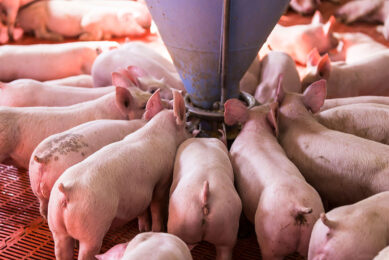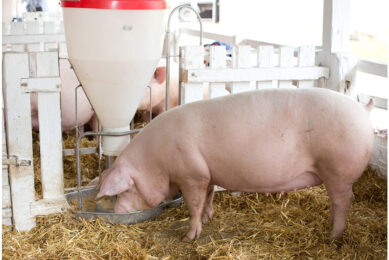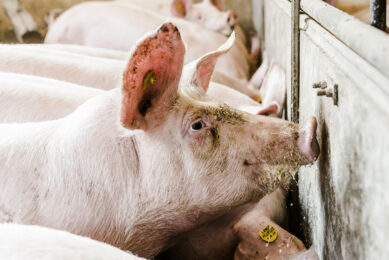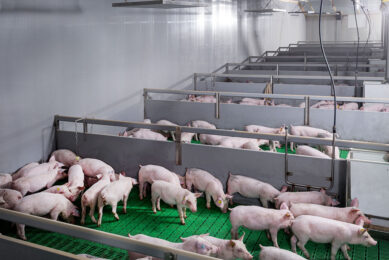Business Update: New pig innovations

New services, products, additives and concepts have been launched to the international pig market recently. Which one can you apply successfully at your pig farm – and where can they be found? This concise overview gets you up to date.
Munters: Metal fans with corrosion protection
Swedish climate control company Munters has launched metal fans that can be used well in swine farms in both warmer as well as colder regions of the world. Metal fans are often not used in swine facilities due to the aggressive environment and risk for corrosion. The company’s new MPX fan series, however, come with coated steel with extremely good resistance performance. The company states its protection factor would be ’10 times better than standard galvanised steel fans’. Bolts, nuts and mesh for EM50 MPX are made in stainless steel, which means that all the components of the fan will contribute to long lasting performance.
Injection moulded pulley set for PU inlets
The Netherlands-based TPI Polytechniek expanded its portfolio with a pulley set unit, suitable for the company’s complete range of central controlled air inlet valves in polyurethane.
The unit offers guidance for the control cord in combination with good support for the main cable or rod. The unit can be mounted to the wall as well as to the air inlet valves which secures the correct position of the unit. The unit can be used in its standard execution and position for cord guidance to the left as well as to the right.
Anco: New nutritional concept
Austrian feed additive company Animal Nutrition Competence (Anco) goes global with Anco FIT to support gut agility. In the face of increasing consumer pressure for antibiotic-free animal diets, supporting gut agility by nutritional means contributes to more robust animals as well as safer and more profitable animal protein production. Applying agile concepts can help to further develop efficiency in animal production. Gwendolyn Jones, head of product management explains, “Gut agility is a new approach in animal nutrition, which describes the animal’s ability to adapt to nutritional stressors in a faster and more energy-efficient response than it normally would. It is also a cost-effective solution to empower animals to cope with mycotoxins in feed more adequately.”
DSM: App for vitamin supplementation
Feed additives company DSM has launched a new app for its 2016 Vitamin Supplementation Guidelines, which help to define the right level of vitamins for 8 groups of farmed and companion animal species. The guidelines also reflect the many factors influencing animals’ feed requirements, ensuring that vitamin fortification does not limit performance. The concept Optimum Vitamin Nutrition (OVN) is centered on enabling livestock producers, and pet owners, to feed animals high quality vitamins in the right amounts and ratios, fitting to their life stage and growing conditions. In practice, OVN is a cost-effective range of vitamin supplementation that optimises animal health, well-being, performance and the quality and nutritional value of animal-origin foods.
Zoetis: Technical manual for M. hyo management
In collaboration with a team of seven Mycoplasma hyopneumoniae (M. hyo) experts, animal health company Zoetis created a new resource for vets with proven strategies and protocols for managing the disease: a technical manual on the disease. The manual was first presented to veterinarians during the American Association of Swine Veterinarians (AASV) in February and March, in New Orleans, LA, United States. {{photo,The manual was developed with the perspectives and experiences of a diverse group of eight experts who represent animal health, academia, diagnostics, swine veterinary practices and a genetics company.
Zoetis goes Web: VOSP & PigCare
Animal health company Zoetis took a road into a media direction when it launched its initiative ‘Voice of Sustainable Pork‘. The company described the platform as ‘a new website focused entirely on sustainable, responsible and successful pork production’, bringing together the four P’s of sustainability: pigs, pork, people, planet. The website comes with a free e-newsletter and can be followed through social media channels.

In addition, in Canada Zoetis was the driving force behind PigCare.ca, an online community for Canadian swine producers, designed to promote animal health and provide resources which respond to the varied needs of a strong community.
Purina: UltraCare Creep Feed
Purina Animal Nutrition introduces UltraCare Creep Feed, a new opportunity for pork producers to create eaters and support optimal pig performance during the weaning period. The new creep feed includes MpD-class palatants developed to mirror the smell and taste of sow’s milk and colostrum. These familiar smells and flavours have been shown in research trials to encourage eating among pre-weaned pigs. Developed with a new gut-optimizing formula, the creep feed can help the evolution of digestive enzymes. At birth, pigs’ guts contain the enzyme lactase to break down lactose in sow’s milk. A different enzyme, amylase, is needed to break down carbohydrates in dry feed. Creep feeding stimulates the development of amylase to give pigs a head start on digesting dry feed.
Piglet prestarter in Provimi portfolio
Animal nutrition company Cargill launched its palatable piglet prestarter in the Provimi portfolio in the UK. Neopigg Go! uses a new approach that involves selecting specific raw materials that are specially blended to enhance digestive system development in the young piglet. In British commercial trials, the new prestarter has been shown to improve daily weight gain and feed efficiency in post weaned piglets.

Cargill developed the prestarter to encourage maturation of the digestive enzymes like amylase and protease that aid the digestion of starches and non-milk derived proteins typically found in starter feed. The high quality soya protein Provisoy
and Cinergy, a blend of stabilised essential oil compounds, are included in the prestarter. The product is in a 1.8 mm pellet derived from raw materials with gelling properties that aid digestion. The pellet size encourages intakes and it is a stable product so it can be used in a liquid diet.
ARM Buildings: Weighing up feed use
UK-based ARM Buildings is supplying load cells to be supplied under feed bins, allowing its customers to monitor feed use at the bin itself. The load cells are linked to the Dicam monitoring system – which the company supplies free for the first 12 months with all new buildings – they provide a continuous and accurate check on feed consumption.
The system provides an early warning of any glitches in the feed supply, such as bridging in the bin, when no feed is being delivered despite the motor running. In addition, a drop in consumption can indicate a potential health problem with the pigs not eating as they should. The buildings need standard broadband connection, but if this is not available then a cellular connection can be installed.
New type of AI lubricating jelly
Aurora Pharmaceuticals launched Clarity, a non-spermicidal A.I. lubricating jelly. The product is a preserved, isotonic, pH buffered, non-spermicidal, water-soluble lubricating jelly for catheter lubrication and all types of non-sterile medical procedures. The jelly is provided in a convenient multi-use squeeze container. Antimicrobial effectiveness testing has shown it will continue to be safe to use even if the product is exposed to contamination from the environment. The viscosity was selected on the ability to cover the catheter tip for easy catheterisation. The jelly was shown to support boar sperm cell functionality in a recent study conducted by an outside laboratory.
Farmex: New brand for data services
More news from the UK: following the increased interest by pig farmers in information communication technology and real-time monitoring on pig farms, Farmex is rebranding all its data services under the Barn Report Pro banner. It will be dropping the Guardian Action name currently used for some of its services. Farmex offers a raft of internet-based IT services on subscription to capture data, including the recently-introduced GrowthSensor it developed in conjunction with ARM Buildings and Dicam Technology. This monitors the growth of finishing pigs as they grow, providing valuable information on a day-to-day basis.
New servospray valve for troughs and bowls
AquaGlobe has developed a new stainless steel, servo spray valve for troughs and bowls made in all stainless steel. The servo feature of the spray valve is new and is easy to open. With just a slight touch on the button the animal can release a water flow of 6 l/min.

Without the servo function it would normally be much harder for the animal to open. With this new valve, there is no need for a lever to help the animal operate a high flow. Fewer moving parts also makes the operation more reliable.
 Beheer
Beheer








 WP Admin
WP Admin  Bewerk bericht
Bewerk bericht